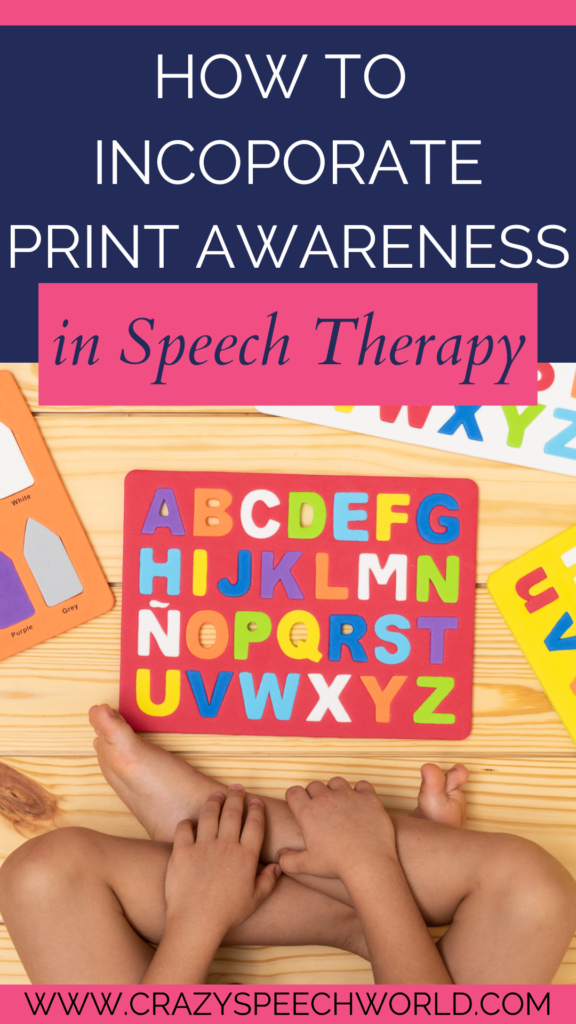Speech-Language Pathologists (SLPs) play a crucial role in children’s language development. One often overlooked but highly beneficial area to incorporate into speech therapy sessions is print knowledge. Understanding the importance of print knowledge can enhance therapy outcomes and foster literacy skills in children. I recently worked on a paper with some colleagues about the importance of this, which you can find HERE.
What is Print Knowledge?
Print knowledge, or print awareness, refers to a child’s understanding of the forms and functions of written language. It includes recognizing letters, understanding that print carries meaning, and knowing how to handle books. Print knowledge is a foundational skill for reading and writing, making it a critical component of early childhood education.
Why Incorporate Print Knowledge?
- Foundation for Literacy: Print knowledge is essential for literacy development. By introducing children to the concept of print, SLPs can help them develop skills that are fundamental for reading and writing, such as letter recognition and phonemic awareness.
- Enhanced Language Skills: Incorporating print knowledge can improve children’s vocabulary, syntax, and narrative skills. Exposure to printed words and books helps children understand how language is structured and used in different contexts.
- Engagement and Motivation: Using books and print materials in therapy can make sessions more engaging and enjoyable for children. Interactive activities involving print can motivate children to participate actively and enthusiastically in therapy.
- Parental Involvement: Encouraging parents to read with their children and integrate print knowledge activities at home can extend the benefits of what they learn in speech therapy. It fosters a collaborative approach, reinforcing skills targeted during sessions.
How to Incorporate Print Knowledge in Speech Therapy
- Interactive Reading: Use storybooks to engage children in interactive reading. Point out letters and words, track the text as you read, and highlight when font or color changes occur in text.
- Letter Recognition Games: Integrate games that focus on letter recognition and sound correspondence. Activities like matching letters to pictures or playing alphabet bingo can make learning fun and effective.
- Environmental Print: Utilize print found in the child’s environment, such as labels, signs, and logos. Discussing these everyday print examples helps children make connections between spoken and written language.
- Writing Activities: Encourage children to engage in writing activities, such as drawing and labeling pictures or creating their own storybooks. These activities reinforce the connection between speech and print.
- Phonological Awareness Games: Combine print knowledge with phonological awareness games. Activities that involve rhyming, segmenting, and blending sounds can be paired with printed words to enhance both phonological and print skills.
Incorporating print knowledge into speech therapy sessions offers numerous benefits for children’s language and literacy development. By integrating interactive reading, letter recognition games, environmental print, writing activities, and phonological awareness games, SLPs can create a comprehensive and engaging learning experience. This approach not only supports speech and language development but also lays the groundwork for successful literacy skills, ultimately benefiting children in their academic and personal lives.
Make sure to check out this article to read more and see speech therapy activity examples you can start using tomorrow!





![Using open ended activities and games in speech therapy can make planning sessions so much easier! Here are a few suggestions that worked well for me. Do you remember the first time you were faced with a mixed group and were realllllllllly unsure about what to do? I do… picture it, St. Augustine 2007 😅 I was […]](https://i.pinimg.com/236x/db/72/cf/db72cf1f6f5da00cb2a13a90872871ea.jpg)
![Using open ended activities and games in speech therapy can make planning sessions so much easier! Here are a few suggestions that worked well for me. Do you remember the first time you were faced with a mixed group and were realllllllllly unsure about what to do? I do… picture it, St. Augustine 2007 😅 I was […]](https://i.pinimg.com/236x/ae/c5/56/aec55688010e2d3489baf744dde59582.jpg)
![Using open ended activities and games in speech therapy can make planning sessions so much easier! Here are a few suggestions that worked well for me. Do you remember the first time you were faced with a mixed group and were realllllllllly unsure about what to do? I do… picture it, St. Augustine 2007 😅 I was […]](https://i.pinimg.com/236x/18/b9/e8/18b9e80227dfe1789e20a21629254f79.jpg)
![Using open ended activities and games in speech therapy can make planning sessions so much easier! Here are a few suggestions that worked well for me. Do you remember the first time you were faced with a mixed group and were realllllllllly unsure about what to do? I do… picture it, St. Augustine 2007 😅 I was […]](https://i.pinimg.com/236x/4d/34/85/4d3485a753178d000223a89b09162317.jpg)
![Using open ended activities and games in speech therapy can make planning sessions so much easier! Here are a few suggestions that worked well for me. Do you remember the first time you were faced with a mixed group and were realllllllllly unsure about what to do? I do… picture it, St. Augustine 2007 😅 I was […]](https://i.pinimg.com/236x/da/7b/c1/da7bc16b9530451d989a578236bc2bff.jpg)
![Using open ended activities and games in speech therapy can make planning sessions so much easier! Here are a few suggestions that worked well for me. Do you remember the first time you were faced with a mixed group and were realllllllllly unsure about what to do? I do… picture it, St. Augustine 2007 😅 I was […]](https://i.pinimg.com/236x/e0/21/a4/e021a465474b16201d23d0a77857935b.jpg)
![Using open ended activities and games in speech therapy can make planning sessions so much easier! Here are a few suggestions that worked well for me. Do you remember the first time you were faced with a mixed group and were realllllllllly unsure about what to do? I do… picture it, St. Augustine 2007 😅 I was […]](https://i.pinimg.com/236x/fa/94/be/fa94be15b6f184b64e2e408bc762a7e8.jpg)
